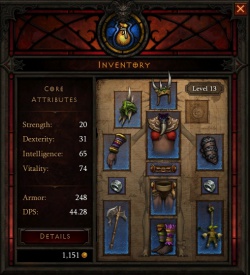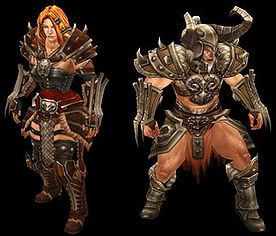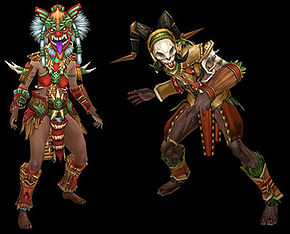Difference between revisions of "Armor"
(added new paper doll) |
|||
| Line 1: | Line 1: | ||
| − | [[ | + | [[Image:Paper doll jan 12.jpg|left|thumb|250px|[[Paper doll]], Jan 2012.]] |
In Diablo III, "Armor" has two meanings. It can be a general term that refers to any type of non-weapon equipment worn by a player. It is also a specific term, a number found on every piece of armor. Heavier armor has a much higher Armor number, which translates to less damage taken by the character wearing it. The benefits of Armor are similar to the benefits of higher [[Defense]], the attribute. | In Diablo III, "Armor" has two meanings. It can be a general term that refers to any type of non-weapon equipment worn by a player. It is also a specific term, a number found on every piece of armor. Heavier armor has a much higher Armor number, which translates to less damage taken by the character wearing it. The benefits of Armor are similar to the benefits of higher [[Defense]], the attribute. | ||
| − | As for armor in general, the equipment is quite changed from Diablo III. There are more types of armor and more slots on the [[paper doll], but fewer individual kinds of armor; D3 offers just 18 pieces of torso armor, compared to 45 in D2X. [[Armor dyes]], [[crafting]], [[socketing]], [[enchanting]], and many other features have also been added to extend the armor finding game. | + | As for armor in general, the equipment is quite changed from Diablo III. There are more types of armor and more slots on the [[paper doll]], but fewer individual kinds of armor; D3 offers just 18 pieces of torso armor, compared to 45 in D2X. [[Armor dyes]], [[crafting]], [[socketing]], [[enchanting]], and many other features have also been added to extend the armor finding game. |
Almost every piece of armor looks very different when worn by each class, and some offer visual differences between male and female as well. | Almost every piece of armor looks very different when worn by each class, and some offer visual differences between male and female as well. | ||
| − | + | {{Clear|left}} | |
==Armor Types== | ==Armor Types== | ||
Revision as of 22:03, 29 January 2012

In Diablo III, "Armor" has two meanings. It can be a general term that refers to any type of non-weapon equipment worn by a player. It is also a specific term, a number found on every piece of armor. Heavier armor has a much higher Armor number, which translates to less damage taken by the character wearing it. The benefits of Armor are similar to the benefits of higher Defense, the attribute.
As for armor in general, the equipment is quite changed from Diablo III. There are more types of armor and more slots on the paper doll, but fewer individual kinds of armor; D3 offers just 18 pieces of torso armor, compared to 45 in D2X. Armor dyes, crafting, socketing, enchanting, and many other features have also been added to extend the armor finding game.
Almost every piece of armor looks very different when worn by each class, and some offer visual differences between male and female as well.
Contents
Armor Types

There are more types of armor to be worn in Diablo III. All the item slots return from Diablo II, plus several new ones; shoulders, pants, and bracers.
Click the following links to learn more about each type of armor. Full listings of all the items in the game will be added once the information becomes available.
- Helms
- Spirit Stones (Monk only)
- Voodoo Masks (Witch Doctor only)
- Wizard Hats (Wizard only)
- Chest Armor
- Cloaks (Demon Hunter only)
- Shields
- Shoulder Armor -- New in Diablo III.
- Bracers -- New in in Diablo III.
- Gloves
- Belts -- These do not hold potions as in Diablo II. They're purely another piece of armor.
- Mighty Belts (Barbarian only)
- Pants -- New in Diablo III.
- Boots
- Rings
- Amulets
Class-Specific Armor
While the developers initially planned not to include class-specific armor types, that changed during game design.[1] As of the beta test, there are numerous types of armor that can only be equipped by one of the character classes. The same goes for weapons.
Individual Armor Appearance
The same piece of Armor in Diablo III will look very different depending on which class is wearing it. This was also true in Diablo II, in most cases, but the designs have been made radically more varied in Diablo III.
Another change is that there are no normal/exceptional/elite item types in Diablo III. In Diablo II the same piece of equipment existed in two different types, with a third (elite) added in the expansion. This meant that characters could find elite armor in Hell difficulty, and armor that looked like cloth would have far more defense than the normal or exceptional version of full plate mail. The Diablo III team didn't like this, and now there are 18 levels of armor to be found, stretching throughout all three difficulty levels. Each of these levels looks quite a bit different from the others.
Though there's alot of variety, there are consistent appearance themes.[2]
- The Witchdoctor’s thematic palette is proving to be very broad. He can wear a lot of cool armor and still look like a Witchdoctor.
Gear Sets
Gear sets are the term the D3 Team uses for the 18 different armor sets. See the gear sets page for full details. A few sample sets, revealed by Blizzard prior to Blizzcon 2010, can be seen below.
Armor Ratings and Stats
The function of Armor is one of the bigger changes in Diablo III's combat engine. In Diablo II, higher armor/defense (the terms were interchangeable) meant a character was less likely to be hit by a physical attack. A D2 character with very high defense could stand in the midst of swinging enemies and hardly be struck at all. As a result of this design feature, the developers had to make monster hits do very high damage, so when one did land, it hurt enough to matter. This resulted in characters taking no damage most of the time, with occasional spikes of very high damage.
In Diablo III, Armor does not reduce enemy to/hit. It reduces damage taken. Thus a D3 character with high armor will still get hit as often as a character with no armor; but each hit will cause much less damage. This, in theory, means that combat will result in a steady drain of hit points, which players must find ways to manage.
Raising your character's defense, the attribute, does much the same thing as higher Armor.
Defense vs. Armor
A key distinction to make, as these are very different values/functions/numbers in Diablo III.
- Armor is a value on all types of armor items. More armor = more damage reduction, but a lot of Armor is required to see significant improvements.
- Defense is one of the four core character attributes/stats. It grows as your character levels up, and can be added as a bonus from items, gems, skills, and more.
Both Armor and Defense increase your character's damage reduction, but Defense offers much larger gains, per point. (But since high level armor items can have many hundreds of points of Armor, both values must be cultivated for long term success.)
Blocking
Blocking is granted by shields and it works much like resistances and Armor do in Diablo III. A shield provides another form of damage mitigation, rather than a way to decrease enemy to/hit. All shields have a % chance to block, and an amount of damage they will absorb upon a successful block. A character's actual blocking % is determined by the shield's number, factored in with attributes, Clvl, and other values.
For example, here are the stats for a Buckler, the lowest level shield in the game:

|
Buckler Common Shield |
[e]
6–7 Armor Durability: 50–70 |
Note that many characters may choose not to use shields, preferring two-handed weapons, dual-wielding weapons, or off hand offensive-boosting items like orbs and mojos.
Resistances
Characters have resistances to fire, cold, arcane, poison, and lightning in Diablo III. There are other types of damage that can not be so directly resisted.
Resistances provide another form of damage mitigation, one tailored to individual types of magical damage. The biggest change to resistances in Diablo III is that they are no longer percentage-based. They are instead like Armor; a number that increases with item and skill bonuses. The higher the number, the more damage they absorb.
This means that characters can always benefit from more resistance, rather than the value capping off at 75%. (Items that add to maximum possible resistance are not found in Diablo III.)
There is no global resistance penalty on the higher difficulty levels in Diablo III, a feature change that allows for more consistent, gradual difficulty changes. No more will characters enter Hell and find their resistances dropped to negative values. Characters will just find that they need more and more resistance to survive against more difficult enemies, in a more linear difficulty increase.
It is not known if any monsters have the ability to lower character resistances, but it seems likely. Nothing equivalent to Diablo 2's Conviction Aura has been seen as a boss modifier in Diablo 3, but such effects might appear at higher difficulty levels.
Various class passive skills can directly increase or decrease character resistances. For instance, the Wizard's passive skill Glass Cannon lowers her resistances and Armor in exchange for greater offensive might.
| {{{icon}}} | [[{{{name}}}]] | 16 | {{{desc}}} |
| Items of Diablo III [e] Item Basics Normal Items Crafting Legendary Armor I Legendary Armor II Legendary Weapons 1h Legendary Weapons 2h Item Sets |
|---|



